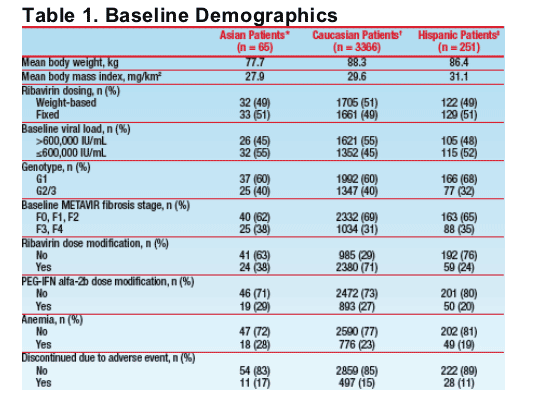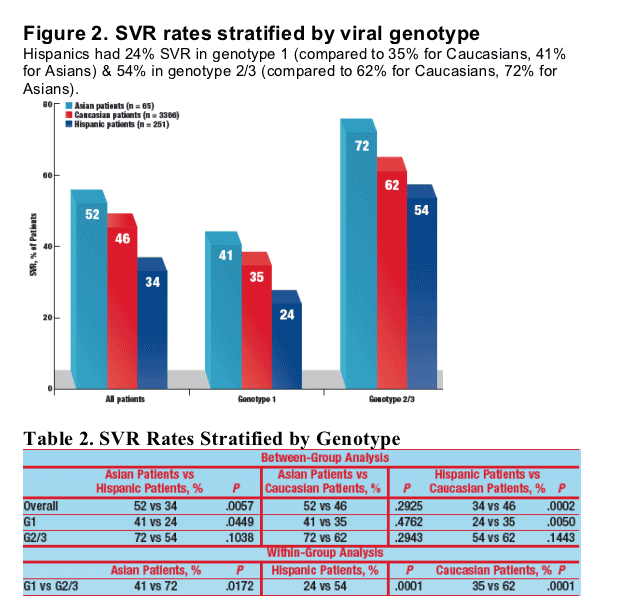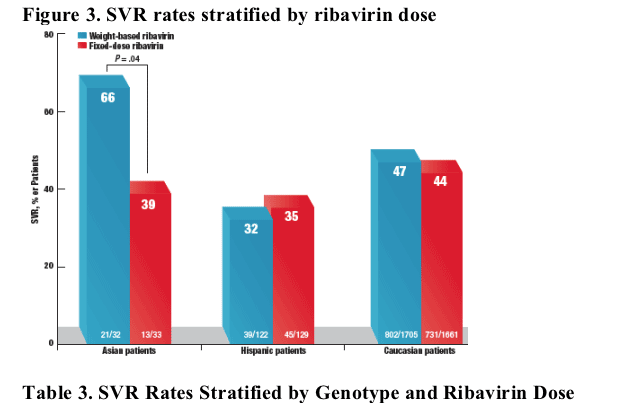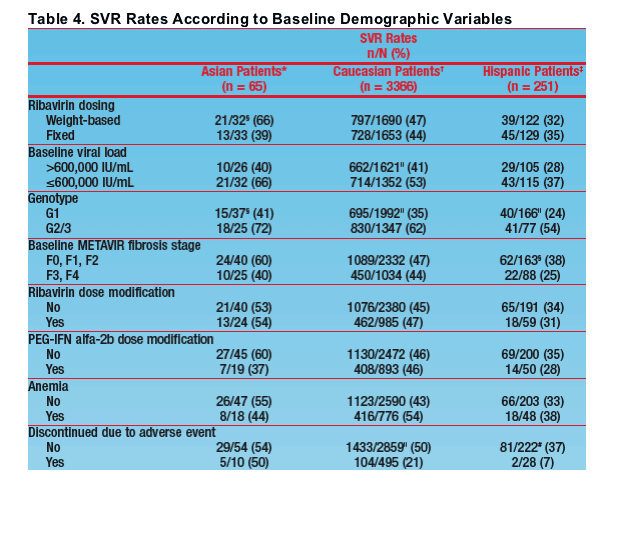 |
 |
 |
| |
Hispanic Responses to PegIntron/RBV in WIN-R Study
|
| |
| |
Reported by Jules Levin
AASLD, Oct 27-31, 2006, Boston, MA
"Prospective Analysis of Sustained Virologic Response to PEG-Interferon alfa-2b and Ribavirin Treatment in Asian and Hispanic Patients With Chronic Hepatitis C: Results From the WIN-R Trial"
Brief Summary: This study is a sub-analysis of the WIN-R Trial to evaluate SVR rates among Asians & Hispanics and compare responses to those in Caucasians. This was a study of over 5,000 treatment-naive patients. The study was prospective, multi-center, community & academic based, open-label, ib=nvestigator-initiated and conducted at 236 sites in the USA, and funded by Schering-Plough. Patients weighed <125 kg (<270 lbs), and randomized to receive PegIntron (1.5 ug/kg/wk) plus oral daily ribavirin (fixed dose or weight-based dose for 48 weeks if genotype 1 or 4 and for 24 or 48 weeks if genotype 2/3. Dose reductions of RBV were required for hemoglobin <10 g/dL and discontinuation required for hemoglobin <8.5 g/dL. Erythropoietin was permitted (EPO) in patients undergoing dose reduction for RBV for hemoglobin <10 g/dL.
Overall SVR rates: 52% for Asians, 46% for Caucasians, 34% for Hispanics. For Genotype 1: 41% for Asians, 35% for Caucaisians, 24% for Hispanics. For genotype 2/3: 72% for Asians, 62% for Caucasians, 54% for Hispanics.
Regarding weight-based dosing vs fixed dose ribavirin. Asians: 66% receiving weight-based dosing (WBD) vs 39% receiving fixed dose (FD) achieved SVR. Hispanics: 32% (WBD) vs 35% (FD) achieved SVR. Caucasians: 47% (WBD) vs 44% (FD) achieved SVR.
B. Freilich,1 K. Hu,2 I. M. Jacobson,3 R. S. Brown, Jr,4 N. Afdhal,5 P. Kwo,6 J. Santoro,7 S. Becker,8 A. Wakil,9 D. Pound,10 E. Godofsky,11 R. Strauss,12 D. Bernstein,13 S. L. Flamm,14 N. Bala,15 V. Araya,16 L. Griffel,17 C. Brass17
1Research Medical Center, Kansas City, Missouri; 2University of California Irvine, Orange, California; 3Weill Cornell Medical College, New York, New York; 4Columbia University Medical Center, New York, New York; 5Beth Israel Deaconess Medical Center, Boston, Massachusetts; 6Indiana University School of Medicine, Indianapolis, Indiana;
7Atlantic Gastroenterology Associates, PA, Egg Harbor Township, New Jersey; 8Austin Gastroenterology, Austin, Texas; 9East Bay Liver Clinic, San Francisco, California; 10Indianapolis Gastrointestinal Research Foundation, Indianapolis, Indiana; 11Bach and Godofsky, MD, PA, Bradenton, Florida; 12Northwest Georgia Gastroenterology Associates, PC, Marietta, Georgia;
13North Shore Long Island Jewish Health System, Manhasset, New York; 14Northwestern University, Chicago, Illinois; 15Gastroenterology Consultants, PA, Houston, Texas; 16Albert Einstein Medical Center, Philadelphia, Pennsylvania; 17Schering-Plough Research Institute, Kenilworth, New Jersey
note from Jules Levin: The study did not define "Hispanic" patients, which is difficult anyway. Some Hispanics may respond differently than others to therapy. I think it is difficult to generalize results to all Hispanics. Response to therapy is individual for all ethnic groups including Hispanics.
SUMMARY
Among Hispanic patients, overall SVR rates were lower than those among Caucasian or Asian patients.
- G2/3 and low baseline viral load were identified as significant predictors of
treatment outcome.
Asian patients achieved higher overall SVR rates than Caucasian patients or Hispanic patients.
- WBD ribavirin and G2/3 were identified as predictors of SVR.
Among Caucasian patients, having low baseline viral load and G2/3 were identified as predictors of SVR.
CONCLUSIONS
Hispanic patients with chronic hepatitis C represent a particularly treatment-resistant population. Additional studies are required to identify factors that will improve SVR rates in this ethnic group.
Overall WBD ribavarin is more effective than FD ribavirin but not in Hispanics)
Asian patients achieve overall SVR rates than are at least equivalent to those observed among Caucasian patients.
-- WBD ribavirin is more effective among Asian patients, especially among G2/3
-- Additional studies among a greater number of Asian patients are required to
confirm results observed in this study.
BACKGROUND
Ethnic origin is an important factor in disease course and response to therapy for patients with chronic hepatitis C.1
-- Reduced response to therapy in African American patients, compared with Caucasian patients, has been extensively reported; however, few studies have evaluated disease course and treatment outcomes in Hispanic and Asian patients.
In Asian and Hispanic patients, specific disease characteristics that may affect treatment outcomes have been reported.
-- Asian patients with chronic hepatitis C are
- At greater risk than Caucasian patients for hepatocellular carcinoma.1
- Likely to be significantly older and have a lower body mass index than patients from other ethnic groups (P < .001 for both comparisons).2
- Hispanic patients with chronic hepatitis C are
- Less likely to have liver cirrhosis but more likely to have steatosis than Caucasian patients.3
- Significantly more likely than Caucasian patients to be coinfected with HIV
(20.4% vs 3.9%, P < .0001).3
Studies with standard interferon (IFN) plus ribavirin therapy suggest that ethnic origin may be an important predictor of response.
-- Sustained virologic response (SVR) rates are highest in Asian patients (61%), followed by Caucasian (39%), Hispanic (23%), and African American (14%) patients.2
-- Hispanic patients have higher rates of treatment discontinuation than Caucasian patients (39.8% vs 28.9%, P = .043), with a trend toward lower end-of-treatment response (27.3% vs 37%, P = .08) and SVR (14.8% vs 22.5%, P = .1).3
REFERENCES
1. Nguyen MH et al. Clin Gastroenterol Hepatol. 2004;2:820-824.
2. Hepburn MJ et al. Am J Med. 20041;117:163-168.
3. Cheung RC et al. Am J Gastroenterol. 2005;100:2186-2193.
4. Jacobson IM et al. Hepatol. 2004;38:61A
AIM
To evaluate SVR rates among Asian and Hispanic patients with chronic hepatitis C who were treated with pegylated interferon (PEG-IFN) alfa-2b (PegIntron) plus ribavirin in the WIN-R trial.
Prospective, multicenter, community- and academic-based, open-label, investigator-initiated study conducted at 236 sites in the United States.
Patients
Patients were treatment naive, had chronic hepatitis C, were 18 to 70 years of age, and weighed <125 kg. Additional inclusion criteria included
-- An elevated alanine aminotransferase level within 6 months prior to entry.
-- A liver biopsy specimen consistent with chronic hepatitis C within 36 months prior to entry.
-- Compensated liver disease.
-- An _-fetoprotein level ≦100 ng/mL in the year preceding entry.
Patients with a positive test result for hepatitis B surface antigen or HIV were excluded.
Treatment
Patients were randomized (1:1) to receive PEG-IFN alfa-2b 1.5 _g/kg/wk administered subcutaneously plus oral, daily ribavirin (fixed dose [FD] or weight-based dose [WBD]) for 48 weeks (genotype 1 [G1], 4, 5, or 6) or for 24 or 48 weeks (G2/3). All patients were followed up for 24 weeks.
Dose reductions of ribavirin were required for hemoglobin (Hgb) level <10 g/dL, and discontinuation was required for Hgb level <8.5 g/dL.
Concomitant use of erythropoietin was permitted in patients undergoing ribavirin dose reduction for Hgb level <10 g/dL.
Assessments
The primary efficacy end point was SVR, defined as undetectable serum hepatitis C virus (HCV) RNA at week 24 after completion of treatment.
The secondary efficacy end point was the difference in SVR rates among patients with G2/3 treated for 24 or 48 weeks.
Safety was monitored by clinical and laboratory evaluations.

SVR Rates by Ethnic Origin and Genotype
Within-Group Analysis
In all 3 patient ethnic groups (Asian, Hispanic, and Caucasian patients), SVR rates were lower for patients with G1 than for patients with G2/3 (Figure 2; Table 2).

Between-Group Analysis
Overall SVR rates (Figure 2; Table 2).
-- Overall SVR rates were lowest among Hispanic patients (34% vs 46% for Caucasian patients, P = .0002, and 34% vs 52% for Asian patients, P = .0057). There was no significant difference in the overall SVR rates between Caucasian and Asian patients.
SVR rates by genotype (Figure 2; Table 2).
-- SVR rates were lowest among Hispanic patients, across all genotypes.
-- Among patients with G1, SVR rates were lowest among Hispanic patients (24% vs 35% for Caucasian patients, P = .005, and 24% vs 41% for Asian patients, P = .0449).
-- Among patients with G2/3, SVR rates among Hispanic patients were lower, but
not significantly different (54% vs 62% for Caucasian patients, P = .1443, and 54% vs 72% for Asian patients, P = .1038).
-- There were no significant differences in the SVR rates between Caucasian and Asian patients across all genotypes.
SVR Rates by Ethnic Origin and Ribavirin Dosing
Within-Group Analysis
Overall SVR rates (Figure 3; Table 3).
Among Hispanic patients, SVR rates were similar between patients receiving WBD or FD ribavirin (32% vs 35%, P = .60).
Among Asian patients, overall SVR rates were greater among those receiving WBD ribavirin than among those receiving FD ribavirin (66% vs 39%, P = .04).
-- On further analyses of SVR rates among Asian patients by genotype, the WBD ribavirin appears to have benefit over FD ribavirin among patients with G2/3 (86% vs 55%, P = .0987) but not among patients with G1 (47% vs 35%, P = .4579).
Among Caucasian patients, the SVR rates were similar among patients receiving WBD or FD ribavirin (47% vs 44% P = .070), irrespective of genotype.


Between-Group Analysis
Overall SVR rates.
-- Among patients receiving WBD ribavirin, the SVR rates were lower in Hispanic patients (32% vs 47% for Caucasian patients, P = .0013 and 32% vs 66% for Asian patients, P = .00008). There was no significant difference in SVR rates between Caucasian patients and Asian patients receiving WBD ribavirin.
-- Among patients receiving FD ribavirin, the SVR rates among Asian patients were not significantly different than those among Caucasian or Hispanic patients. However, SVR rates were lower among Hispanic patients (35% vs 44% for Caucasian patients, P = .0410 and 35% vs 39% for Asian patients, P = .6299).
SVR rates by genotype.
-- Among patients with G1 receiving WBD or FD ribavirin, there was no significant difference between patients of different ethnic origin.
-- Similar results were observed among patients of different ethnic origin with G2/3 receiving WBD or FD ribavirin.
-- SVR rates were lower among Hispanic patients.

|
| |
|
 |
 |
|
|